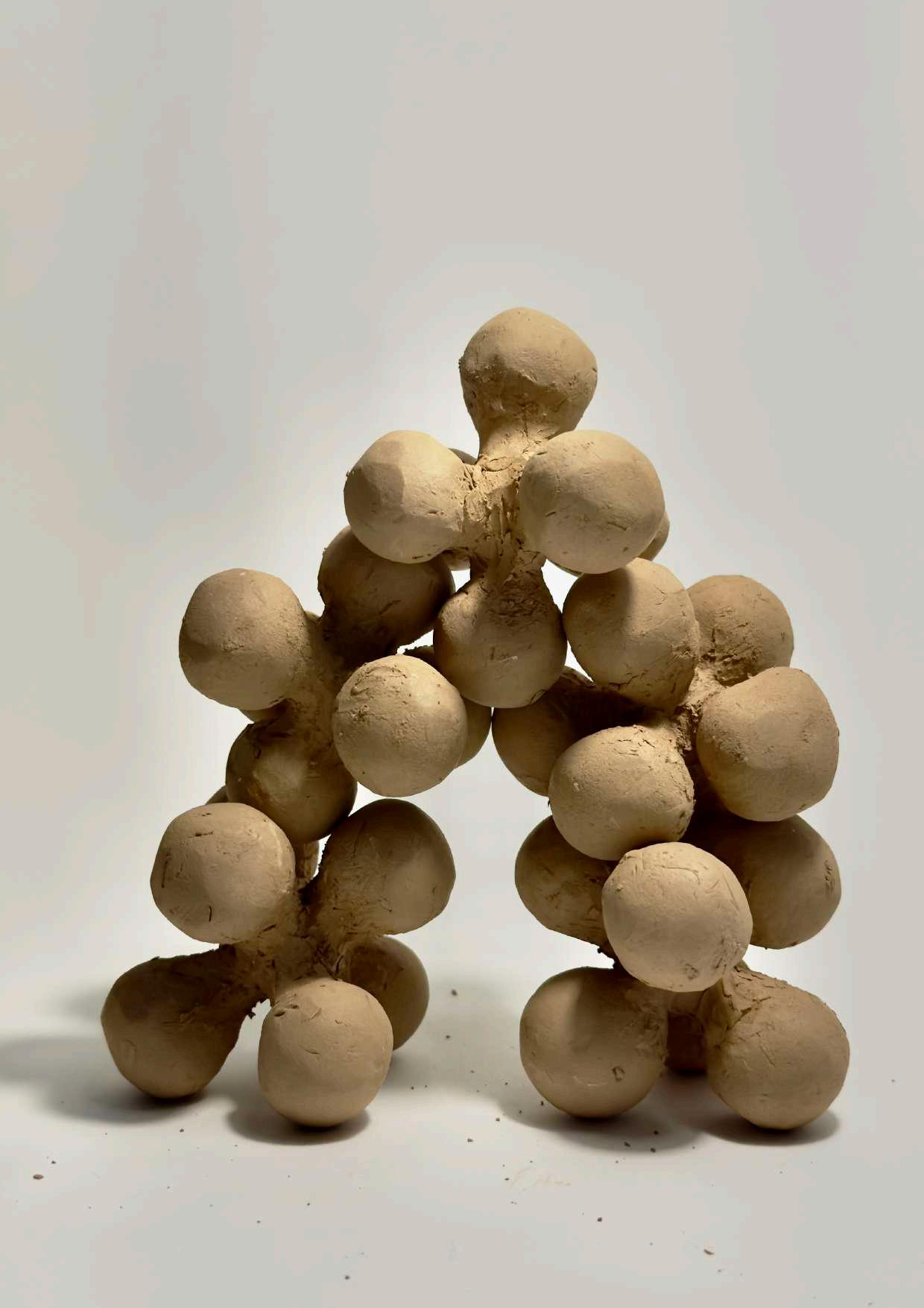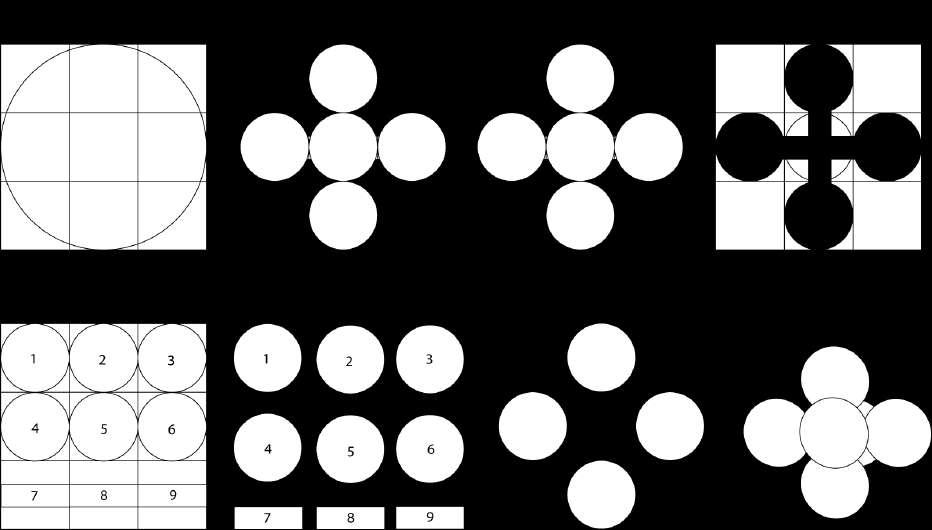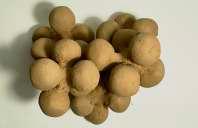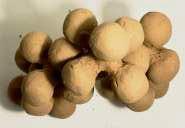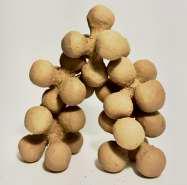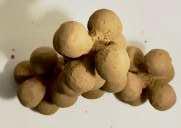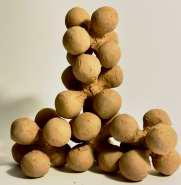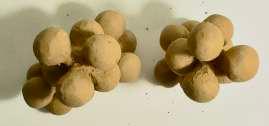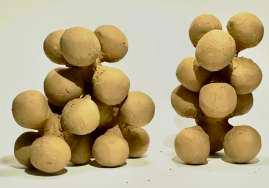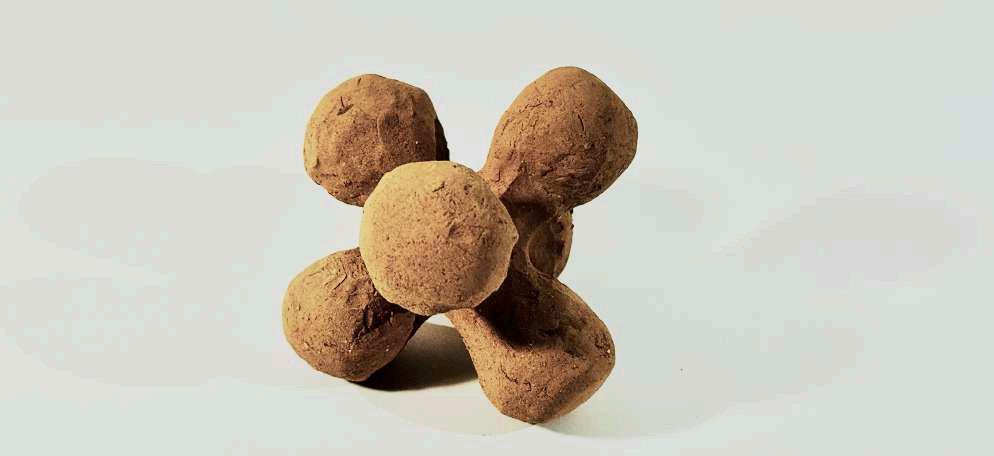Enhancing Marine Biodiversity Through Modular Structures
SISSEL MARIE MORLEY
Author: Sissel Marie Morley
Institution: Griffith University, Gold Coast Campus
Department: Griffith School of Environment and Science
Date: Summer Scholarships program 2025 (07/02/2025)
OF CONTENTS
◦ Underwater Sculpture Installations | Jason deCaires Taylor
◦ Reformative Coral Habitats | Reef Tiles
◦ Modular Artificial Reef Structure (MARS) | Reef Design Lab
INTRODUCTION
Artificial reefs (AR) are submerged structures placed into deliberate location.They play a key role in restoring damaged ecosystems by providing structures that promote biodiversity and support marine life. Features like texture, shape, and material are crucial for encouraging the growth of organisms like corals and algae (Leonard et al., 2022). These reefs are designed to support marine species while withstanding erosion, aligning with environmentally responsible construction guidelines (OSPAR Commission, 2013).
The "Living Architecture" research proposes a multidisciplinary approach that integrates coral ecosystems into design processes. This approach focuses on ecological and architectural sustainability, recommending bio-enhancing surfaces tailored for coral growth and tools to aid in planning underwater structures providing coastal protection (Linaraki, D., Stevens, T., Baumeister, J., & Burton, P., 2023).
The Museum of Underwater Art (MOUA) in Australia has also been studied for its use of specific materials to create artificial reefs. At John Brewer Reef, surveys of the world's largest underwater sculpture showed significant increases in fish diversity and numbers. In 2018, 12 species and 65 individuals were recorded, compared to 46 species and 365 individuals in 2022 (Adam Smith et al., 2022). These results highlight the positive impact of artificial reefs on marine ecosystems.
Advances in 3D printing have further enhanced the design of artificial reefs, allowing for the creation of complex ceramic structures with improved ecological functions (Berman et al., 2023). For example, the "Reformative Coral Habitats | Reef Tiles" project, conducted by the Robotic Fabrication Lab and the Swire Institute of Marine Science (SWIMS) at the University of Hong Kong, aims to restore coral habitats in Hoi Ha Wan Marine Park, Hong Kong.
The Reef Design Lab focus on the creation of artificial habitats tailored to enhance marine biodiversity, collecting data for research of the outcome of various design methodologies (Vogler, V. 2022). Base on the environment location and supporting ecosystem, this multidisciplinary studio combines architecture, science, and technology to create solutions that promote ecological restoration and habitat enhancement (Takens, V. 2024).
The RDL Team is base in Melbourne are responsible for the development of a diverse range of products: EMU modules shaped concrete mixed with oyster shells to reduce coastal erosion in Port Phillip Bay (Tian Lin 2023). Modular Artificial Reef Structure (MARS), 3DP modular unit specially designed geometry with irregular surface to support transplanted coral, made from ceramic from slip cast modes, the parametric geometry triangle structural complex (Maslov et al. 2024).
Using pottery and ceramics in artificial reefs is emerging as a sustainable restoration strategy. These materials show great potential due to their durability, eco-friendliness, and ability to support marine biodiversity. Research highlights ceramics as a promising option for reef restoration (Kalam et al., 2018). Hybrid methods, combining traditional and digital techniques, have been used to create microhabitats suited for artificial reef systems (Trilsbeck et al., 2019). Clay 3DP is used to replicate complex coral habitat in a modular scale,(Levy et al., 2022). The ceramic material used has an estimated density of 3,800 kg/m³ (3.8 × 10³ kg/m³). With a specified thickness of 2 cm (0.02 m) and a layering height of 7 mm (0.007 m), the weight of a cubic meter of this printed ceramic is approximately 1 ton (1,000 kg). This accounts for the clay's natural humidity content of about 20%.
RESEARCH QUESTION AND OBJECTIVES
This research hypothesised that an architectural design structure can be implemented to the submarine landscape to support the survival, regeneration and growth of the marine ecosystem. The concept archetype to aid biodiversity by design an optimum underwater structural habit composition (Linaraki, D., Stevens, T., Baumeister, J., & Burton, P., 2023).
This study focused on the use of clay as the main materials in the creation of artificial reef architectural structures to develop an expanding structural system that supports marine biodiversity and ecosystem restoration.
Research question asks: How can an architectural artificial reef structure, guided by design principles, enhance marine habitat and support biodiversity?
The primary research: Optimised architectural design AR solution.
The objectives of this research is to explore the unique properties of the coral reef structures and identify the characteristics of an optimum architectural design structure. Explore a variety of design solutions to generate cohesive prototype model that can be replicate scale and reproduced. Aiming to mimic the complexity of natural reefs while allowing for scalable growth and integration into various marine environments.
The secondary research: Clay’s properties to support a prototype model to be used as AR. How clay can be used as a sustainable, versatile, durable, and textured material that is compatible with supporting coral and algae growth for reef restoration. A key goal is to investigate how clay's natural adaptability and textural properties can be enhanced through hybrid techniques, such as combining traditional and advanced technologies, to create a prototype model that can be scaled and modular. This research also seeks to examine the chemical composition of clay and its structural properties, focusing on how these factors impact and are influenced by marine biodiversity. It will analyse clay’s ability to attract and support marine life while maintaining structural integrity against erosion and destruction caused by the natural underwater environment.
The results of this research will culminate in a comprehensive report that provides recommendations and guidance for future artificial reef structures. By addressing these objectives, the study aims to determine whether clay-based materials and design methodologies can contribute to the development of sustainable and innovative solutions for artificial reef design, aligning ecological restoration goals with architectural advancements.
CORAL SYSTEM
Coral reefs are three-dimensional complex system considered one of the most diverse ecosystems on Earth. Consists of colonies of soft-bodied polyps which are the fundamental organism of coral. Corals are often classified into two main types: hard corals (Scleractinia), which build reef structures, and soft corals, which lack a rigid calcium carbonate skeleton. Supporting Marine Life consists of algae, sponges and bivalves mussels (responsible for filter, the water in creating micro habitats) fishes in order forms of life that aid to the ecosystem development, by contribute to the food production.
Anatomy of Corals:
• Polyps: Corals are made up of thousands of small, soft-bodied polyps. Each polyp has a sac-like body with a central mouth surrounded by tentacles.
• Skeleton: Hard corals secrete calcium carbonate (CaCO₃) to build exoskeletons, creating the reef structure over time.
• Symbiosis with Zooxanthellae: collaborative relationship with microscopic algae called zooxanthellae, which live in their tissues. These algae provide corals with nutrients through photosynthesis and give them their vibrant colours.
The life cycle of corals includes reproduction both sexually and asexually. The sexual process called “coral spawning”, enhances genetic diversity, resilience and expand colonisation into new ares. Fragmentation is asexual reproduction of corals, when a portion of a coral colony breaks off and forming a new independent colony.
These mechanisms are critical for maintaining coral populations and ensuring the structural integrity of reefs in dynamic marine environments (Linaraki et al., 2023).
The generation of biogenic sediments, formed from fragments of broken down coral due to erosion. Bioerosion is a naturally occurring process which can be caused by bioeroders and/or destroyers. These sediments consist primarily of calcium carbonate (CaCO₃) or silica (SiO₂) (Araújo, M. E. 2024).
Coral reef shape form is influenced by location topographic, water flow, depth and other factors. The geometry is an important factor and plays a crucial role on the success or failure of the colony that inhabited it (Brandes 2020)
CASE STUDIES
1. Underwater Sculpture Installations | Jason deCaires Taylor Multiple Global Locations | Marine and Freshwater Environments
Active Dates: 2006 – Present
British sculptor and environmentalist Jason deCaires Taylor is a pioneer in aquatic art installations and has created over 1,200 underwater sculptures. These works span 14 sites worldwide, including 12 in marine environments and two in freshwater ecosystems, blending artistry with ecological restoration.
In Australia, “The Coral Greenhouse” at John Brewer Reef, part of the Museum of Underwater Art, this large scale under water architecture designed to evolve with nature, illustrates how “Living Architecture” underwater structures (Linaraki, D., Stevens, T., Baumeister, J., & Burton, P., 2023), can enhance and promote a sustainable marine life habits. The triangular cross section with elevated beam design is engineered to have a low centre gravity to improve stability. Made from pH neutral cement compounds and corrosion resistant 316 Stainless steel. Demonstrated significant increases in fish diversity and numbers from 2018, 12 species and 65 individuals were recorded, in compared to 46 species and 365 individuals in 2022 (Adam Smith et al., 2022). These results highlight the positive impact of artificial reefs on marine ecosystems.
Figure 1, The Coral Greenhouse
2. Reformative Coral Habitats | Reef Tiles
Robotic Fabrication Lab | Faculty of Architecture | The University of Hong Kong
Active Dates: August 2019 - July 2020
The coral restoration project by The University of Hong Kong, aimed to create terracotta reef tiles structures that provide complex support and promote coral attachment opportunities for expansion and natural growth. These reef tiles are designed to prevent sedimentation buildup, with gaps on allow debris and sedimentation to pass through it. By incorporating biomimetic patterns and spaces for securing coral fragments. A total of 128 reef tiles, each with a diameter of 600 mm, were produced using a robotic 3DP clay printing method.
The pilot study focuses on three coral species—Acropora (staghorn corals), Platygyra (brain corals), and Pavona (leaf corals)—selected for their varying growth strategies and adaptability to environmental stressors. Deployed at three sites within the marine park: Coral Beach, Moon Island, and sheltered bay, near the WWF Marine Life Education Center, Hong Kong.
The project has demonstrated a significant increase in coral survivorship compared to traditional restoration methods. Archireef, a company that emerged from this initiative, reports a 95% coral survival rate after three years, which is more than four times higher than that achieved with conventional techniques. This success has been attributed to the biomimetic design of the tiles, which mimic natural coral structures and provide a conducive environment for coral growth.
3. Modular Artificial Reef Structure (MARS) | Reef Design Lab
Field Implementation: Multiple locations
Active Dates: January 2018 – July 2020
The MARS project employs scalable hexagonal structures made of ceramic outer shell which encourages the natural recruitment of juvenile corals and facilitates the attachment of transplanted corals. The structural complexity provides shelter and breeding grounds for diverse aquatic species.
The modular design allows for customisable configurations, adapting to specific site conditions. Measuring 1.2 meters in diameter, integrates openings and surface textures inspired by natural reef systems to promote attachment of aquatic organisms, mitigate sediment accumulation, and enhance habitat complexity. Initial findings show a significant uptick in aquatic species diversity and population density around the structures compared to non-reef areas, demonstrates potential for integrating sustainability and urban waterway restoration.
Reef Design Lab
Australia: 2017-2018 VIC, pilot studies.
Maldives: 2018 coral nurseries and support biodiversity.
Singapore: 2019 urban coastal waters.
Thailand: 2019 impacted by tourism and environmental stressors.
Indonesia: 2019-2020 reef rebuilding.
Fiji: 2020 support coral nurseries and coastal resilience.
Figure 2, Reef Tiles
Figure 3, MARS
DESIGN FINDINGS
The presented design findings diagram categorises the performance of various design parameters, using a colour scheme (green, yellow, red) to indicate effectiveness across multiple criteria. Overall, the findings indicate that circular geometries consistently outperform in ecological, hydrodynamic, and functional metrics, making them the optimal choice for this project. Square configurations offer viable alternatives with moderate effectiveness, while triangular shapes are generally less favourable across evaluated parameters.
Figure 8, Design findings diagram illustrating optimal design outcomes. Green represents the most effective design configurations, yellow indicates moderate performance with potential for improvement, and red highlights the least favourable outcomes requiring significant revision.
John Brewer Reef
MATERIAL
Clay is a material that is studied in geotechnical engineering due to its high plasticity, permeability, bearing capacity, and settlement characteristics. The theoretical formula is ((OH)4Si8Al4O20·NH2O nterlayer) and the theoretical composition without the interlayer material is SiO2, 66.7%; Al2O3, 28.3%; and H2O, 5%.
2KAlSi3O8 + 2CO2 + 11H2O —> Al2Si2O5(OH)4 + 2K+ + 4H4SiO4 + 2HCO3K-feldspar + carbon dioxide + water -> kaolin + potassium, silica and bicarbonate ions in solution
From: C3S formation: 3CaO+SiO2→3CaO·SiO. C2S formation: 2CaO+SiO2→2CaO·SiO.
BRAND - Feeney’s Clay (manufactured) from Walker Ceramics (company), due to historical significance established in Victoria, Australia 1885. Feeney’s is locally havant and manufactured from natural sustainable sources.
CLAY SELETION - TERRA COTTA
KILN - The kiln is a high temperature oven designed to solidifies the clay by the firing process, in three stages: drying, oxidation and finishing (or soaking). Complex chemical and physical transformations will happen to the molecular level during those stages.
KILN SPECIFICATION - WARD Kiln (Australia) Electric 240 Volt-Internal Size 330 mm x 300 mm
Firing temperature 1000*C for 6hrs.
Figure 9, Illustration of structured geometric design based grid-based, demonstrating various spatial arrangements.
INSTRUCTION PROCESS
The final design parametric design optimised mathematical tiling principles composed from a grid 3x3 layout system base to allow scalability and modularity to remain consistent. Cross-shaped formation with central axis in X, Y Z directions, connected to six spheres one at the end of each axis point.
CONSTRUCTION PROCESS
The construction methodology prioritises capability, adaptability and ensuring flexibility during deployment, to withstand hydrodynamic pressures and accommodate ecological variations. The parametric design framework ensures the fluid dynamics, enabling efficient sediment transport, coral larval settlement, and the collection of fragmented coral propagules, thereby enhancing biodiversity potential (Brandes, 2020 ). Prototypes are crafted using eco-friendly traditional clay techniques, aligning with sustainable practices emphasised in reef restoration research (RRAP, 2024 ).
Construction Method:
Step 1. Make six spheres and three axis, Step 2. Assemble two spheres connected to single axis, Step 3. Make a total of three sets, Step 4. Join all three set at point zero of each axis.
Shaping Techniques:
• Option 1: Hand-Carved Method
◦ Roll clay by hand into shapes.
◦ Connect parts as per diagrams using slip (Clay+ water mixture) as “glue” and score to join the pieces securely.
• Option 2: Pottery Wheel
◦ Create pots as round as possible, living small opening at top,
◦ Create cilinders
◦ Once semi dry, assemble parts using slip (Clay+ water mixture) as “glue” and score to join the pieces securely.
• Option 3: Plaster Moulds (for Reproduction)
◦ Create a positive model of the design.
6X 3X
3X 1X
◦ Pour liquid plaster over the model to create a reusable mould.
◦ Once dry, use the mould to pour liquid clay (slip) into the mould, let it harden before removing it.
Figure 10, Construction method diagram
MODULARITY
The design of artificial reefs (ARs) can be optimised through a modular approach that enhances scalability, ecological functionality, and adaptability across diverse marine environments. Implementing modularity allows for flexible configurations that can be customised to suit varying ecological and environmental conditions. This approach ensures that reef structures remain resilient to external stressors while providing suitable habitats for marine life. The four key modularity principles integrated into AR design include:
1. Number of test models used on test configuration, five.
2. Interlocking units are designed to fit together seamlessly, forming structurally stable formations that can withstand strong hydrodynamic forces. Their modular nature allows for incremental expansion, making the reef adaptable to different spatial requirements and environmental conditions.
3. Cellular aggregation mimics the growth patterns of natural coral colonies by incorporating biomimetic porous frameworks. These modules feature hollow chambers or perforated surfaces, creating protected micro habitats for marine organisms while promoting water flow and nutrient exchange. This structure facilitates species settlement and provides shelter for juvenile fish and invertebrates.
4. Adaptive tessellations involve customisable geometric configurations that can be arranged to optimise ecological performance. By adjusting the tessellated structures based on environmental factors such as sunlight exposure and sedimentation, the reef can better integrate into its surroundings and support diverse marine ecosystems.
5. Segregated surface modules focus on a compartmentalised composition that enhances marine organism attachment and coral recruitment. These modules consist of separated but interconnected units, mimicking natural reef formations and allowing for controlled ecological interactions.
By integrating these four modular principles, the artificial reef structure ensures functional adaptability, long-term ecological sustainability, and structural resilience, effectively mimicking the complexity of natural coral reefs while supporting biodiversity and marine habitat restoration
Figure 11, Four different modularity explorations focusing on spacial results.
2.
FINAL MODEL
The final artificial reef model was designed with transportability, structural integrity, and ecological functionality as primary considerations. Measuring 3000mm × 3000mm × 3000mm, this modular artificial reef structure ensures ease of transportation and deployment while maintaining an optimal scale for marine habitat restoration.
To facilitate efficient transport and assembly, the structure is composed of interlocking modular units, which can be disassembled and reassembled on-site. These modules are crafted from marine-grade, eco-friendly materials, promoting coral recruitment and marine biodiversity. Recent advancements in additive manufacturing have demonstrated the potential of materials such as cementitious composites and biogenic substrates, which enhance the ecological compatibility of artificial reefs (Matus et al., 2024) . The lightweight yet durable construction enables easy handling and precise underwater positioning, ensuring seamless integration into various marine environments.
The model integrates biomimetic cellular aggregation, adaptive tessellations, and segmented surface modules, which enhance water flow dynamics, nutrient exchange, and organism attachment. Studies on hydrodynamics-driven artificial reef designs have shown that optimising reef structure for fluid interaction can significantly influence marine biodiversity recruitment and long-term reef stability (Silva, 2022) . Additionally, the porous design fosters habitat creation, allowing for colonisation by a diverse range of marine species, while also supporting long-term reef development (Smith, Cook, & Molinaro, 2021) .
By balancing scalability, ecological efficiency, and logistical feasibility, the final model presents a highly adaptable solution for artificial reef implementation. This approach aligns with contemporary marine restoration strategies, ensuring long-term success in biodiversity conservation and habitat restoration (Kikuchi et al., 2024) .
Figure 12, Final model.
CONCLUSION
This study explored the optimisation of artificial reef structures through a multidisciplinary design approach that integrates architectural principles with marine habitat restoration strategies. In response to the first research question: How can an architectural artificial reef structure, guided by design principles, enhance marine habitat and support biodiversity?The findings indicate that modular, biomimetic, and hydrodynamical optimised reef structures significantly improve ecological integration. The research highlights how artificial reefs can mimic natural coral reef habitats, increasing species recruitment and habitat complexity (Matus et al., 2024).
For the second research question: How can clay be used as a sustainable material for artificial reef prototypes? The study confirms that clay's high durability, porosity, and eco-compatibility make it a viable material for coral settlement and marine biodiversity enhancement. Experimental results and case studies demonstrate that textured ceramic surfaces promote coral adhesion, while modular clay-based structures offer scalability and adaptability in reef restoration efforts (Trilsbeck et al., 2019) .
Overall, this research contributes to the field of marine restoration and ecological architecture by providing a replicable model for designing sustainable artificial reefs. Future research should focus on long-term ecological monitoring, exploring how "Living Architecture" driven parametric modelling and biodegradable materials can further optimise and explored.
AKCKNOWLEGMENT
I respectfully acknowledge the Traditional Custodians of the land and sea on which this research was conducted, and I pay my respects to Elders past, present, and emerging. Their deep connection to Country and knowledge of marine ecosystems inspire ongoing efforts toward environmental stewardship and sustainable practices.
THANK YOU
I extend my sincere gratitude to Griffith University and the Griffith Sciences Summer Scholarships program for supporting this research. Special thanks to Yvette Baxter, Executive Support Officer, Research, Griffith Sciences, for her invaluable assistance. I also deeply appreciate the guidance and expertise of Dr. Despina Linaraki, Lecturer in Architecture, Design, and Technology, and Dr. Vincent Raoult, Senior Lecturer in Marine Ecology, from the School of Environment and Science, Griffith Sciences. Their insights and mentorship have been instrumental in shaping this study and advancing my understanding of sustainable artificial reef design.
1. Bayraktarov, E., Wilson, K., Stewart-Sinclair, P. J., Brisbane, S., Boström-Einarsson, L., Saunders, M. I., Lovelock, C. E., Possingham, H. P., & Mumby, P. J. (n.d.). Motivations, success, and cost of coral reef restoration. University of Queensland. https://doi.org/10.1111/rec.12977
2. Guerreiro da Silva, B. G. (2022). Hydrodynamics driven design of coastal artificial reefs [Master’s thesis, University of Algarve]. University of Algarve.
3. Hassan, O. H., Abidin, S. Z., Legino, R., Anwar, R., & Kamaruzaman, M. F. (Eds.). (2015). International Colloquium of Art and Design Education Research (i-CADER 2014). Springer Science+Business Media. https://doi.org/ 10.1007/978-981-287-332-3
4. MOUA Monitoring Plan. (2021). MOUA Monitoring Plan 2021. Reef Ecologic. https:// www.researchgate.net/publication/349759761_MOUA_Monitoring_Plan_2021
5. Omaki, N., Nakayenga, J., Awazu, S., & Hata, T. (2023). Evaluation of long-term durability of slag-treated clay under seawater exposure. Proceedings of the 9th International Congress on Environmental Geotechnics (9ICEG).
6. Reef Design Lab. (2018). Modular Artificial Reef Structure (MARS) – Maldives Project. Retrieved from https://www.reefdesignlab.com/
7. Reef Trust Partnership. (2024). Reef Trust Partnership – Great Barrier Reef Foundation. Great Barrier Reef Foundation. Retrieved from https:// www.barrierreef.org
8. The Great Barrier Reef Foundation. (2021). Reef 2050 Long-Term Sustainability Plan 2021–2025. Australian Government. https://www.awe.gov.au/
9. 3DPrint.com. (2020, September 9). Projects that are restoring coral reefs by 3D printing them. Retrieved from https://3dprint.com/271739/7-projects-that-arerestoring-coral-reefs-by-3d-printing-them/
10. Brandes, J. (2020). Design and analysis of the performance of an artificial reef to protect the Southern Rhode Island shoreline [Master’s thesis, University of Rhode Island]. Digital Commons @ URI. https://digitalcommons.uri.edu/theses/1902 .
11. Guerreiro da Silva, B. G. (2022). Hydrodynamics driven design of coastal artificial reefs [Master’s thesis, University of Algarve]. University of Algarve .
12. Kikuchi, R. K. P., Leão, Z. M. A. N., Araújo, M. E., & Lotufo, T. C. M. (Eds.). (2024). Brazilian coral reefs: A multidisciplinary approach. Springer Nature. https://doi.org/ 10.1007/978-3-031-59152-5 .
13. Matus, I. V., Alves, J. L., Góis, J., Vaz-Pires, P., & Barata da Rocha, A. (2024). Artificial reefs through additive manufacturing: A review of their design, purposes and fabrication process for marine restoration and management. Rapid Prototyping Journal, 30(11), 87–122. Emerald Publishing. https://doi.org/10.1108/ RPJ-07-2023-0222 .
14. Reef Restoration and Adaptation Program. (2024). Home - Reef Restoration and Adaptation Program. Great Barrier Reef Foundation. https://gbrrestoration.org/
15. Smith, A. K., DiBattista, J., Tol, S., & Kustra, L. (2024). Field guide to fishes of the Coral Sea Marine Park, Queensland, Australia. https://inaturalist.ala.org.au/guides/ 19461 .
16. Berman, O., Weizman, M., Oren, A., Neri, R., Parnas, H., & Shashar, N. (2023). Design and application of a novel 3D printing method for bio-inspired artificial reefs Ecological Engineering, 188, 106892. https://doi.org/10.1016/ j.ecoleng.2023.106892​:contentReference[oaicite:0]{index=0}.
17. Florisson, J., & Tropiano, M. (2017). Artificial reefs in Australia: A guide to developing aquatic habitat enhancement structures. Recfishwest .
18. Kalam, M. A., & Casareto, B. E. (2018). Development of artificial reefs using environmentally safe ceramic material. Journal of Ecosystem & Ecography. https:// doi.org/10.4172/2157-7625.1000253​:contentReference[oaicite:2]{index=2}.
19. Linaraki, D., Stevens, T., Baumeister, J., & Burton, P. (2023). Opportunities for integrating corals as fundamental elements in the architectural design of underwater structures in coral reef environments. Griffith University .
20. Leonard, C., Hédouin, L., Lacorne, M. C., Dalle, J., Lapinski, M., Blanc, P., & Nugues, M. M. (2022). Performance of innovative materials as recruitment substrates for coral restoration. Restoration Ecology, 30(7), e13625. https://doi.org/10.1111/ rec.13625​:contentReference[oaicite:4]{index=4}.
21. Levy, N., Berman, O., Yuval, M., Loya, Y., Treibitz, T., Tarazi, E., & Levy, O. (2022). Emerging 3D technologies for future reformation of coral reefs: Enhancing biodiversity using biomimetic structures based on designs by nature. Science of the Total Environment, 830, 154749. https://doi.org/10.1016/ j.scitotenv.2022.154749​:contentReference[oaicite:5]{index=5}.
22. Maslov, D., Cruz, F., Pinheiro, M., Miranda, T., Valente, I. B., Ferreira, V., & Pereira, E. (2024). Functional conception of biomimetic artificial reefs using parametric design and modular construction. Journal of Marine Science and Engineering, 12, 1682. https://doi.org/10.3390/jmse12091682​:contentReference[oaicite:6]{index=6}.
23. Smith, A., Songcuan, A., Cook, N., & Brown, R. (2022). Engineering, ecological and social monitoring of the largest underwater sculpture in the world at John Brewer Reef, Australia Journal of Marine Science and Engineering, 10(11), 1617. https:// doi.org/10.3390/jmse10111617​:contentReference[oaicite:7]{index=7}.
24. Smith, A. K. (2024). Field guide to fish of John Brewer Reef, Queensland, Australia. iNaturalist. https://www.inaturalist.org/guides/ 19383​:contentReference[oaicite:8]{index=8}.
25. Trilsbeck, M., Gardner, N., Fabbri, A., Haeusler, M. H., Zavoleas, Y., & Page, M. (2019). Meeting in the middle: Hybrid clay three-dimensional fabrication processes for bio-reef structures. International Journal of Architectural Computing, 17(2), 148-165. https://doi.org/10.1177/1478077119849655​:contentReference[oaicite:9] {index=9}.
26. Boström-Einarsson, L., Babcock, R. C., Bayraktarov, E., Ceccarelli, D., Cook, N., Ferse, S. C. A., Hancock, B., Harrison, P., Hein, M., Shaver, E., Smith, A., Suggett, D., Stewart-Sinclair, P. J., Vardi, T., & McLeod, I. M. (2020). Coral restoration – A systematic review of current methods, successes, failures and future directions. PLOS ONE, 15(1), e0226631. https://doi.org/10.1371/ journal.pone.0226631​:contentReference[oaicite:0]{index=0}.
27. Frias-Torres, S., Montoya-Maya, P. H., & Shah, N. (Eds.). (2018). Coral Reef Restoration Toolkit: A Field-Oriented Guide Developed in the Seychelles Islands Nature Seychelles .
28. Hein, M. Y., McLeod, I. M., Shaver, E. C., Vardi, T., Pioch, S., Boström-Einarsson, L., Ahmed, M., & Grimsditch, G. (2020). Coral reef restoration as a strategy to improve ecosystem services – A guide to coral restoration methods. United Nations Environment Programme. https://doi.org/10.3354/ meps13206​:contentReference[oaicite:2]{index=2}.
29. Lange, C., Ratoi, L., & Lim Co, D. (2020). Reformative Coral Habitats: Rethinking Artificial Reef Structures through a Robotic 3D Clay Printing Method. The University of Hong Kong .
30. Linaraki, D., Stevens, T., Baumeister, J., & Burton, P. (2023). Opportunities for integrating corals as fundamental elements in the architectural design of underwater structures in coral reef environments. Griffith University .
31. McLeod, I. M., Bourne, D., Ceccarelli, D. M., Boström-Einarsson, L., Cook, N., Fulton, S. E., Hancock, B., Harrison, P., Hein, M., Le Port, A., Paewai-Huggins, R., Smith, H. A., & Smith, A. (2020). Best practice coral restoration for the Great Barrier Reef: Synthesis of results. Report to the National Environmental Science Program. Reef and Rainforest Research Centre. https://doi.org/10.1016/ j.ecoleng.2020.106892​:contentReference[oaicite:5]{index=5}.
32. Paxton, A. B., Foxfoot, I. R., Cutshaw, C., Steward, D. N., Poussard, L., Riley, T. N., Swannack, T. M., Piercy, C. D., Altman, S., Puckett, B. J., Storlazzi, C. D., & Viehman, T. S. (2024). Evidence on the ecological and physical effects of built structures in shallow, tropical coral reefs: A systematic map. Environmental Evidence, 13(12). https://doi.org/10.1186/s13750-024-00336-3​:contentReference[oaicite:6] {index=6}.
33. Randall, C. J., Negri, A. P., Quigley, K. M., Foster, T., Ricardo, G. F., Webster, N. S., Bay, L. K., Harrison, P. L., Babcock, R. C., & Heyward, A. J. (2020). Sexual production of corals for reef restoration in the Anthropocene. Marine Ecology Progress Series, 635, 203–232. https://doi.org/10.3354/ meps13206​:contentReference[oaicite:7]{index=7}.
34. Won, D. (2023). A review of coral reef restoration methods. Bergen County Academies .
35. United Nations Environment Programme (UNEP). (2020). Best practices for coral reef restoration and ecosystem services improvement. UNEP.
36. De Lestang, S., How, J., Erbe, C., & Rushworth, K. (2024). Boom, shake the room: Seismic surveys affect behaviour and survival of western rock lobster Fisheries Research, 277, 107072. https://doi.org/10.1016/ j.fishres.2024.107072​:contentReference[oaicite:0]{index=0}.
37. Han, C., Pang, X., Liu, W., Fu, W., Guo, B., Kinoshita, T., Zheng, D., Yamashita, O., Feng, J., & Lu, X. (2024). Comparison of floating and traditional artificial reef areas using an ecosystem-based approach in the Dashentang area of Bohai Bay, China. Fisheries Research, 277, 107085. https://doi.org/10.1016/ j.fishres.2024.107085​:contentReference[oaicite:1]{index=1}.
38. Glemarec, G., Kroner, A. M., & Kindt-Larsen, L. (2024). Disappearing fish: Grey seal depredation in a Baltic net fishery. Fisheries Research, 277, 107070. https://doi.org/ 10.1016/j.fishres.2024.107070​:contentReference[oaicite:2]{index=2}.
39. Ortega, A., Reglero, P., de la Gándara, F., Mourente, G., & Blanco, E. (2024). Effects of temperature on embryonic development of Atlantic bluefin tuna (Thunnus thynnus, L 1758) and Atlantic bonito (Sarda sarda, Bloch 1793). Fisheries Research, 277, 107066. https://doi.org/10.1016/ j.fishres.2024.107066​:contentReference[oaicite:3]{index=3}.
40. Hutchinson, E., Matthews, T. R., Ross, E., Hagedorn, S., & Butler, M. J. IV. (2024). Gastric mill ossicles record chronological age in the Caribbean spiny lobster (Panulirus argus). Fisheries Research, 277, 107083. https://doi.org/10.1016/ j.fishres.2024.107083​:contentReference[oaicite:4]{index=4}.
41. Mota, K. G., Perazza, C. A., Velho, F. V., Sardinha, M. L., Morais, L., Oliveira Vaini, J., Hallerman, E., & Hilsdorf, A. W. S. (2024). Population genetic diversity of Cunene horse mackerel Trachurus trecae on the Angolan coast: Implications for management and conservation. Fisheries Research, 277, 107069. https://doi.org/10.1016/ j.fishres.2024.107069​.
42. Lennert-Cody, C. E., De La Cadena, C., McCracken, M., Chompoy, L.,Vogel, N. W., Maunder, M. N., Wiley, B. A., & Altamirano Nieto, E. (2024). Within-well patterns in bigeye tuna catch composition and implications for purse-seine port-sampling and catch estimation for the Eastern Pacific Ocean. Fisheries Research, 277, 107079.
IMAGE REFERENCES
Figure 1. The Coral Greenhouse, Museum of Underwater Art (MOUA), Australia.
Figure 2. Reef Tiles – The University of Hong Kong.
Figure 3. Modular Artificial Reef Structure (MARS) – Reef Design Lab.
Figure 4. Design strategy diagram illustrating functional applications of artificial reefs.
Figure 5. Site Location – John Brewer Reef, Townsville, Australia.
Figure 6. Physical prototype models showcasing modularity concepts.
Figure 7. The best-selected model designs with optimised parameters.
Figure 8. Design findings diagram illustrating optimal design configurations.
Figure 9. Geometric spatial arrangements for modular reef structures.
Figure 10.Construction method diagram.
Figure 11. Modularity exploration models in top and side views.
Figure 12. Final model.
AUTO-CORRECTION NOTES
To improve the accuracy and readability of this research document, an automated correction process was applied using. This included AI:
• Grammar and Spelling Corrections: Adjustments were made for typos and grammatical inconsistencies.
• APA 7 Formatting Adjustments: Citations and references were checked and formatted correctly.
• Clarity Enhancements: Some sentences were restructured for better readability.
• Image Captions and References: Proper labels and sources were assigned to all images used in the document.
• Consistent Terminology: Standardised terminology across the document to maintain academic precision.
